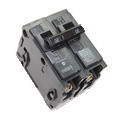How to Fix an In Rush Power Problem and Tripped Circuit Breaker
 '; ';
|
How to Fix a Tripping Dedicated Circuit: This solution would be much safer than installing a larger circuit breaker which I definitely do not recommend. © By: Dave Rongey |
Guide to Circuits for Welders and Motors
Electrical Question: Running a Miller Dialarc HF welder using 6/3 input cable and a 50A circuit breaker.
- The inrush current often trips the breaker, after I get the breaker to hold all works fine.
- This is a dedicated circuit for the welder.
- Is there a breaker that is less sensitive to inrush, and is still sensitive to heat rise?
- GE 200 amp panel about 4 years old.
Thanks,
Gordon
This electrical wiring question came from Gordon in Arvada, Colorado.
Additional Comments: I am often amused by the questions, never by your answers.
Dave’s Reply:
Thanks for your electrical wiring question Gordon.
How to Fix a Tripping Dedicated Circuit
Application: Dedicated Electrical Circuit.
Skill Level: Intermediate to Advanced – Best installed by a Licensed Electrical Contractor or Certified Electrician.
Tools Required: Basic Electricians Pouch Hand Tools and a Voltage Tester.
Estimated Time: Depends on personal level experience, ability to work with tools and the available access to install the circuit and electrical connection box.
Precaution: Identify the circuit, turn it OFF and Tag it with a Note before working with the wiring connections.
- The Problem: Tripping Breaker of a Dedicated Circuit
- Circuits for equipment that require a dedicated circuit should be sized carefully to prevent a tripping breaker or blown fuse.
- This is especially true for welders and equipment that have a motor, such as air compressors.
- In Rush Electrical Current Explained
- When equipment first starts there is an initial demand of electricity for the process to begin. With motor loads this is referred to a LRA or Lock Rotor Amps, which is the amount of amperage that is required to start a motor.
- Due to the in rush current that takes place when the equipment starts the load can multiply several times which can cause a tripped circuit breaker.
- Commercial and Industrial Equipment Circuits
- For commercial and industrial applications his can be prevented by sizing the circuit properly and installing motor starter controls with overload protection that allows for the initial in rush of power.
- Home and Workshop Equipment
- The concern of in rush current concern is also true for some home workshop equipment, however the solution is not to increase the size of the circuit breaker.
- In most cases a magnetic circuit breaker is designed to handle the initial flow of in rush current.
- The Solution: Wire and Circuit Breaker Sizing
- The problem of in rush current may be best avoided if the circuit wire and breaker are both sized larger together to allow for the initial in rush current load.
- This solution would be much safer than installing a larger circuit breaker which I definitely do not recommend.
- The wire or cable being used for these types of circuits should be stranded copper for best results.
More about Wiring Electrical Circuits
Electrical Wire for the Home
Complete listing of electrical wire types and parts used for home projects with electrical code information serves as selection guidelines.
House Wiring Circuits and Circuit Breakers
This article looks at common 120 volt and 240 volt house wiring circuits and the circuit breakers that are installed identifying the types and amperage sizes used in most homes.
Home Electrical Circuit Breakers
Home Electrical Circuit Breakers
A guide to home electrical circuit breakers and how they work to protect your electrical wiring. When properly installed, your home electrical wiring is protected by a circuit protection device.
The following may also be helpful for you:
|
|
Be Careful and Be Safe - Never Work on Energized Circuits!
Consult your Local Building Department about Permits and Inspections for all Electric Wiring Projects.
More articles about Electrical Wiring and Home Electrical Wiring: |
|
| « Previous | Next » |
Splicing 220 Volt Wiring |
Replacing a Dimmer With A Light Switch |

















